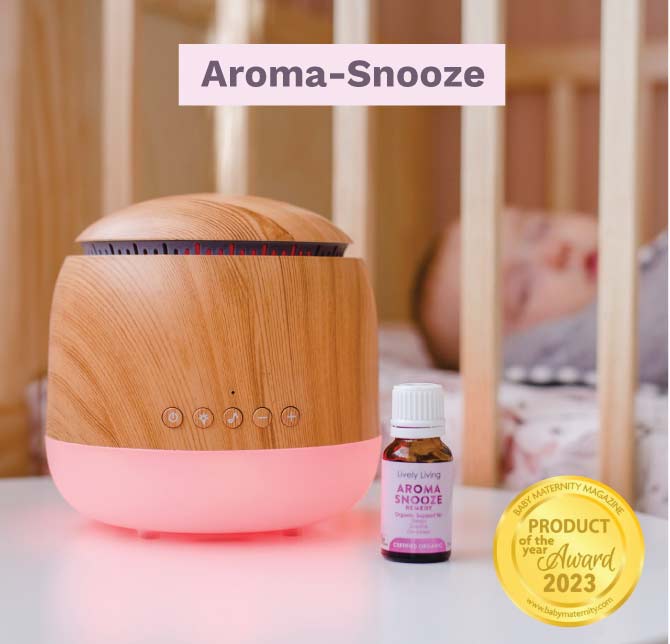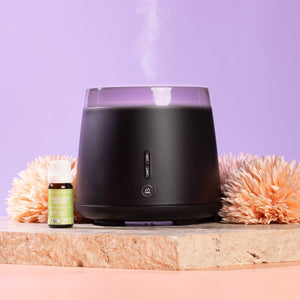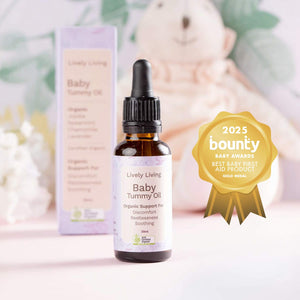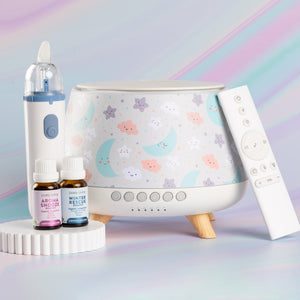Teething 101: Signs, Symptoms, and Soothing Strategies
Teething is a natural milestone in your baby's development. It can be challenging for both parents and infants. As primary teeth emerge, you might wonder what's normal and how to soothe your baby's discomfort. With the right knowledge and tools, navigating teething becomes easier. Using Baby and Child Essential oils can help soothe and comfort. Let's explore everything about teething, from recognizing the signs to finding relief for your baby.
Table Of Contents:
-
Understanding the Teething Process
- Recognizing the Signs of Teething
- Soothing Your Teething Baby
- Caring for Your Baby's New Teeth
- When to Seek Help
- FAQs about teething
- Conclusion
Understanding the Teething Process
Teething is when a baby's teeth break through their gums. It's a normal part of development. It can cause discomfort and irritability for some babies. Most infants start teething between 4 and 7 months old.
Teething can begin as early as 3 months or as late as 12 months. There is financial assistance for dental needs available for qualifying families in some cases. Here’s a short time guide about the teething process as provided by dental association and patient education resources.

When Do Babies Start Teething?
Every baby is different. There's a general timeline for when teeth appear. Consulting a healthcare professional may provide soft fruit or hard foods recommendations, depending on baby's age. The soft-bristled toothbrush is introduced with the first tooth.
- Bottom front teeth (lower central incisors): 6 to 10 months.
- Top front teeth (upper central incisors): 8 to 12 months.
- Top lateral incisors (either side of top front teeth): 9 to 13 months.
- Bottom lateral incisors (either side of bottom front teeth): 10 to 16 months.
- First molars (back teeth): 13 to 19 months.
- Canines (pointed teeth next to lateral incisors): 16 to 22 months.
- Second molars: 25 to 33 months.
This is just a guide. Some babies might teethe earlier or later than the teeth called average schedule. This natural process shouldn't cause worry. By age 3, children should have 20 primary teeth.

Recognizing the Signs of Teething
Teething can be tricky. Some babies experience no discomfort, others struggle. There's no general guide as each infant experiences a slightly rise in fussiness at their own level. Understanding teething babies is key to a calm environment.
Recognizing common signs of teething is important. If the baby chews, offer baby safe teething toys for their oral health and the healthy teeth it helps ensure. Keeping track of a baby's teeth is a great tool for parental reassurance and knowledge. If baby's gums or babyâs gums are swollen for an extended period or are red swollen, it is advisable to seek professional care.
Physical Signs
- Swollen, tender gums.
- A visible tooth below the gum.
- Excessive drooling.
- Flushed cheeks or face.
- Rash around the mouth from drooling.
Behavioral Signs
- Increased irritability or fussiness.
- Trouble sleeping.
- Loss of appetite.
- Rubbing their face or pulling their ear.
- Biting or chewing on objects.
Many associate fevers with teething. Research doesn't confirm this connection. A temperature above 100.4°F (38°C) warrants a pediatrician visit.

Soothing Your Teething Baby
Discomfort is distressing. Several ways exist to ease teething pain. The search search for solutions never ends and thankfully teething remedies are quite extensive.
Try chilled yogurt or applesauce if baby has started solid foods. Homeopathic remedies can be explored with your child's pediatrician to rule out anything that could hurt your child, such as teething tablets, and discuss pain medicines and other recommendations.
Safe Teething Remedies
- Gum Massage: Gently rubbing your baby's gums with a clean finger can provide soothing teething relief.
- Cold Compress: A chilled (not frozen) washcloth or teething ring can numb gums and reduce inflammation.
- Teething Toys: Offer safe, BPA-free teething toys. The pressure alleviates discomfort. This crying baby may benefit greatly from something to gnaw on.
- Cold Foods: Chilled foods, like yogurt or applesauce, soothe sore gums.
- Essential Oils - Making a roller oil with the Lively Livings baby and Child Essentia oils, including the Child Calming Remedy and applying to the cheek can help soothe your child.
What to Avoid
Avoid harmful remedies when helping your baby. A dental visit for your baby within 6 months of their first tooth coming in is important for healthy teeth and a solid start to dental care and oral health. Teething necklaces and amber teething necklaces pose safety risks.
- Teething Gels with Benzocaine: The FDA warns against these due to the risk of methemoglobinemia.
- Amber Teething Necklaces: These are choking hazards with no proven effectiveness.
- Teething Tablets: Some homeopathic teething tablets have inconsistent amounts of belladonna.
Consult your pediatrician before using medication or remedies. Homeopathic teething tablets and pain medicines need to be discussed with a physician.
Caring for Your Baby's New Teeth
Once teeth emerge, start dental care. Good habits start early.
Infant formula should never be given in a bottle when going to sleep. When teeth start, care should also start.
Early Dental Care Tips
- Clean baby's gums before teeth appear with a damp cloth.
- Brush twice daily with a soft-bristled toothbrush and a rice-sized smear of fluoride toothpaste after the first tooth erupts. The upper central incisors typically come in around 8-12 months.
- Schedule the first dental visit by their first birthday, or within six months of the first tooth's arrival.
- Avoid putting your baby to bed with a bottle, as this can lead to cavities.
Baby teeth are essential for chewing, speaking, and guiding permanent teeth. Proper care ensures good oral health.
When to Seek Help
Teething is generally benign, but sometimes a pediatrician visit is necessary. Upper central teeth come in later than the lower ones.
If your teething baby is consistently fussy or if teething pain persists, contacting a healthcare provider is crucial. These may be teething symptoms or caused by other underlying issues that need to be assessed. If you notice any changes or signs of an infection in baby's teeth, schedule an appointment request as soon as possible.
- If your baby has a fever over 100.4°F (38°C).
- If teething causes severe pain or distress.
- If your baby refuses to eat or drink for an extended period.
- If you notice signs of infection, such as pus or swelling.
- If your child hasn't started teething by 18 months.
Trust your instincts. Contact your healthcare provider if concerned. Early intervention can prevent cavities. Teething rings are often helpful.
FAQs about teething
When do babies start teething?
Most babies start teething between 4 and 7 months old. It can start as early as 3 months or as late as 12 months. Every baby develops differently. The molars emerge later on, starting around 13-19 months.
How to know if baby has teething pain?
Signs include irritability, drooling, swollen gums, and chewing on objects. Your baby might rub their cheek or ear, have trouble sleeping, or eat less. Not all babies experience pain. Teething babies may exhibit these signs, however. Sometimes upper teeth break through the gums first, even though the bottom two central incisors tend to emerge before the rest.
How can I soothe my teething baby?
Soothe your baby by massaging their gums, offering cold teething rings or washcloths, and providing safe teething toys. Cold foods like yogurt can help babies eating solids. Consult your pediatrician before giving infant acetaminophen or ibuprofen. Consider how to chill teething rings appropriately and safely.
How long does teething pain last?
Teething pain usually lasts about 8 days, starting 4 days before the tooth emerges and lasting 3 days after. This varies by baby and tooth. Some babies may experience longer discomfort, others none. While we've referred to upper teeth, we mean the baby's teeth start coming through in the top of the mouth or the upper part of the gums. If teeth start coming through sooner or later than usual, this is still usually normal.
Conclusion
Teething is a milestone in baby's development. It marks their journey towards a full set of teeth. It can be challenging, but understanding the process and providing relief can make it smoother.
Every baby is different. What works for one might not work for another. Be patient, observant, and seek help when needed. With the right approach, you and your baby will navigate teething, emerging with a healthy smile.




















